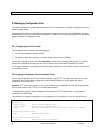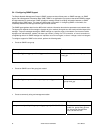
• Designated port—connects to the designated switch, which has the lowest path cost when forwarding packets
from that LAN to the root bridge. The port through which the designated switch is attached to the LAN is called
the designated port.
• Alternate port—offers an alternate path toward the root switch to that provided by the current root port.
• Backup port—acts as a backup for the path provided by a designated port toward the leaves of the spanning
tree. A backup port can exist only when two ports are connected together in a loop-back by a point-to-point link
or when a switch has two or more connections to a shared LAN segment.
• Disabled port—has no role in the operation of the spanning tree.
A port with the root or a designated port role is included in the active topology. A port with the alternate or backup port
role is excluded from the active topology.
Rapid Convergence
RSTP provides for rapid recovery of connectivity following the failure of a switch, switch port, or LAN. It provides rapid
convergence for edge ports, new root ports, and ports connected through point-to-point links as follows:
• Edge ports—If a port on a switch running RSTP is assigned to be a edge port, it will be put to forwarding
immediately. However, the edge port will be in the RSTP initialization state and will send out the RSTP BPDUs
with the operating status of edge port set to TRUE. If the edge port starts receiving the BPDUs, it will change the
operating edge state to FALSE and start the spanning tree calculations. It is recommended to assign any ports
that are to be left as a “leaf” of the LAN (with no connection to any bridge) as edge ports.
• Root ports—If the RSTP selects a new root port, it blocks the old root port and immediately transitions the new
root port to the forwarding state.
• Point-to-point links—If you connect a port to another port through a point-to-point link and the local port becomes
a designated port, it negotiates a rapid transition with the other port by using the proposal-agreement handshake
to ensure a loop-free topology.
Note that if the link type of the port is not forced, the switch makes the decision of link type by operating duplex mode
of the port. Also, a port with full-duplex mode is considered as a point-to-point link type, and a port in half-duplex
mode is set as shared link type.
5.5.3 Configuring spanning-tree
Enabling/Disabling Spanning-tree
Use the configuration mode command below to enable/disable spanning tree on the switch.
Command Purpose
spanning-tree forceversion 8021w
spanning-tree forceversion none
Enable Rapid spanning-tree(802.1W) on the
switch.
Disable spanning tre on the switch
42 Asante IntraCore IC39240/480 User’s Manual


















